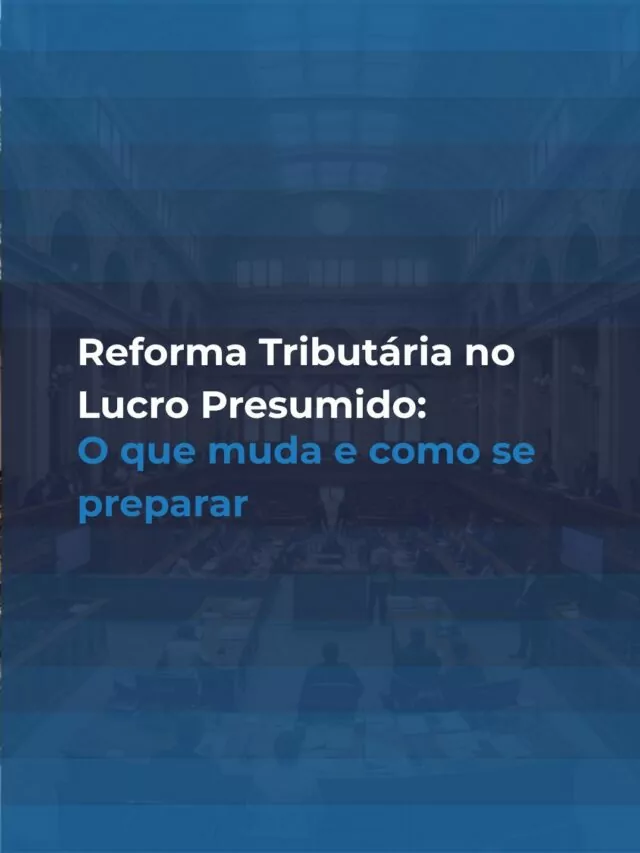Currently, Brazil is one of the few countries that no tax on profits and dividendsThe policy has been in place since 1995. That is about to change. From 2026, a new 10% taxation on dividends. Bill No. 1.087/2025 has already been approved by the Chamber of Deputies and the Federal Senate in November 2025, and is now awaiting presidential sanction.
This project also creates a minimum effective income tax for high incomes, ensuring that those earning over R$ 600,000 a year pay at least a percentage of around 10% in income tax.
There will also be a exemption limitThe first R$ 50,000 per month in dividends per source of payment will be exempt; what exceeds this amount will be taxed. In plain language, if you are a shareholder and receive high dividends, you will need to prepare to pay tax on part of these amounts in 2026. In the following topics, we explain what exactly will changewhich companies and entrepreneurs will be affected and how you can anticipate to minimize impacts.
Do you want to understand in a practical way what will change in the taxation of dividends in 2026?
In the new episode of the CLM Controller podcast, Beatriz Oliveira talks to Marco Aurélio Ribeiro and Rodrigo Ribeiro about the impacts of the new rule on companies and investors.
Play and stay on top of the updates that will transform the accounting landscape in 2026.
Main changes
The main changes planned in the taxation of profits and dividends for 2026 are:
Dividend taxation
Profits and dividends distributed to an individual in excess of R$ 50 thousand a month (by same company) will now have 10% Withholding Income Tax (IRRF). In other words, the paying company will withhold 10% from the amount exceeding the limit and pay it to the Revenue Department.
Observationdividends remitted abroad will also be subject to IRRF 10%, according to the new rules. Until 2025, these dividends were totally exempt from IRRF for the beneficiary shareholder, so this is a significant change after ~30 years without taxation.
Minimum income tax for high incomes
A Minimum Personal Income Tax (IRPFM)applied to those who receive over R$ 600 thousand in the year adding up all sources of income.
This minimum tax will have progressive rates, reaching 10% on total income for those who earn from R$ 1.2 million/year. In practice, it will work as a adjustmentWhen the annual tax return is filed, the effective rate paid by the taxpayer will be calculated. If it is lower than the minimum, the difference is charged until the percentage due is reached.
Example: if a very high-income taxpayer managed, after deductions, to pay only 5% of effective tax, he will have to pay another 5% to complete the 10% minimum.

Only a few exceptions are left out of the calculation, such as capital gains on the sale of real estate, indemnities, donations/inheritance, savings income, benefits exempt due to serious illness, etc.
Exemption for retained earnings until 2025 (transition rule)
Profits and dividends related to results calculated up to the year 2025 will continue to be exempt from the new tax, provided that the distribution of these profits is approved by December 31, 2025. In other words, the company needs to formalize (in a meeting, balance sheet or equivalent corporate document) the allocation of profits by the end of 2025.
You don't have to pay everything immediately - the money can actually be released to the partners over 2026, 2027 and 2028, tax-free, as long as the distribution was approved in 2025. This measure aims not to penalize old profits that have already been booked.
Attention: old profits that no are approved for distribution by 31/12/2025 will lose their exemption and, if distributed from 2026 onwards, will be taxed by the 10% at source. For this reason, many entrepreneurs are moving to anticipate distribution profits and reservations before the end of 2025, avoiding the new charge.
Changes in income tax legislation
All these changes are part of the Bill No. 1.087/2025, authored by the Executive, approved at the Chamber of Deputies on 01/10/2025.
Bill 1087/25 will amend the Income Tax Act to implement an exemption of up to R$ 5,000 (for individuals) and minimum taxation on high income and dividends.
The text was to be voted on in the Federal Senate and, if sanctioned without amendments, will come into force on January 1, 2026. The expectation is for broad approval (in the House it was unanimous), so entrepreneurs should consider these rules practically certain for next year's planning.
What still needs to happen to be valid in 2026
What still needs to happen to be valid in 2026 (updated version)
Despite the fact that January 1st, 2026, The legislative process has not yet been fully completed.
O Bill No. 1.087/2025 has already been approved by the Chamber of Deputies and the Federal Senate, But it still needs to go through a few formal stages before it can take effect.
Who will be affected?

The new taxation of dividends and the minimum effective tax will mainly target taxpayers from higher incomeBut this includes various profiles of companies and entrepreneurs. In simple terms, any individual who receives profits above the limit (R$ 50,000 per month from the same company, or > R$ 600,000 per year in total) will be impacted. The main ones affected will be:
Partners of Presumed Profit and Real Profit companies
Owners and partners of small and medium-sized enterprises which usually withdraw a large part of their profits as exempt dividends, will now have a tax cost on these withdrawals.
Service companies with high profit margins are a typical example: many partners paid a minimum pro-labore and distributed the rest of the profit exempt. Now, for monthly amounts above R$ 50,000 per company, there will be 10% of IR. This affects everyone from self-employed professionals with their own company (doctors, lawyers, consultants, etc.) to medium-sized entrepreneurs.
Note: even those who opted for the Simples Nacional can be achieved if the company generates high profits to the point where the shareholder withdraws more than R$ 600,000/year in dividends (a less common situation, but possible in some cases).
Family holdings
Structures holding are often used to concentrate a family's assets (shares in companies, real estate, investments) and distribute income to members (parents, children, spouses).
These dividends from holding companies who were previously exempt, will now be subject to withholding of 10% if they exceed R$ 50,000/month per beneficiary. Investing families, heirs and partners in holding companies should beware: there will be an impact both on the distribution of operating profits (from companies in the group) and on investment income that the holding company passes on to the partners.
Succession planning via holding companies will need to be revised to take tax efficiency into account in this new scenario.
Individual investors and shareholders
Who invest Anyone who invests in shares or is a shareholder in S/A companies will also be affected. Dividends from publicly traded companies, real estate funds and the like, which used to be exempt, are now taxed if the investor receives more than R$ 50,000 per month from the same company. In practice, ordinary investors with modest positions don't reach this level per company.
However, large investors who receive high volumes of dividends (for example, majority shareholders or those who concentrate investments) may be able to withhold them.
In addition, investors with various sources passive income (rent, interest, smaller dividends from various companies) may not be subject to monthly withholding on any of them, but even so, if the annual sum exceeds R$ 600,000, they will be included in the minimum tax adjustment. In other words, high income of investments will now face direct taxation.
Read also: The informality of rents is over, see what changes!
Entrepreneurs and self-employed professionals
Many individual entrepreneurs and professionals (such as consultants, doctors, dentists, engineers, etc.) open companies (LTDA or Eireli) and adopt the strategy of receiving an low pro-labore + profit distribution to pay less tax (since salary pays up to 27.5% of IRPF + INSS, while profits were exempt). This model will become less advantageous above the limit of R$ 50,000/month.
For example, a doctor who owns a clinic and today earns R$ 100,000 a month in profits (excluding income tax) and only a small salary, in 2026 would have ~R$ 5,000 withheld at source every month on the portion above the limit.
These professionals will need to re-evaluate how much they receive as pro-labore versus dividends. The good news is that the salary exemption band will rise to R$ 5,000 a month, but above that the normal IR table (up to 27.5%) applies. It will be a balance to be calculated on a case-by-case basis.
According to government estimates, around 141,000 taxpayers fall into this high-income profile and will be directly affected by the taxation of dividends and minimum income tax. In general, these are people with a monthly income of more than R$ 50,000, concentrated in the richest regions of the country (Southeast and South). If you are part of this group - or aim to be, in the case of growing companies - it is essential to understand the new rules and act proactively.
Comparative table - Current situation vs. new taxation
To summarize the changes, the table below compares the situation by the end of 2025 with the rules from 2026 on dividend taxation and planning strategies:
| Aspect | Until 2025 | From 2026 |
|---|---|---|
| Tax on dividends | 0% - Exempt from personal income tax. | 10% - Withholding tax on amounts above R$ 50 thousand/month. |
| Exemption limit | No limit - Any amount is exempt. | R$ 50 thousand/month per beneficiary per company (R$ 600 thousand/year). Surplus is taxed. |
| Minimum IR | It doesn't exist - only the progressive table applies (up to 27.5%). | Taxpayers with an annual income above R$ 600 thousand will have a minimum rate between 0% and 10%. If the IR paid is lower, the difference will be charged in the adjustment. |
| Accumulated profits until 2025 | Exempt forever - can be distributed without IR. | They only remain exempt if distribution is approved by 31/12/2025 (payment by 2028). Otherwise, they will be taxed. |
| Strategies | Distribute retained earnings and adjust pro-labore up to 31/12/2025. | Plan withdrawals within the R$ 50 thousand, review pro-labore, use JCP (15%)and consider corporate reorganizations. |
Practical guidelines for companies and partners
Faced with these changes, 2025 is a key year to take measures that reduce the impact taxation of dividends.
Here are some practical guidelines on what companies and their partners should do still in 2025:
- Distribute retained earnings before 2026
Anticipate the approval and distribution of retained earnings (from previous years and 2025) until 31/12/2025. Amounts approved up to that date will continue exempt from income taxeven if paid later. Also include profit reserves, if any, and check with your accountant to make sure you're within the legal limits. This way, you'll "clean out" your cash without paying the 10% of future taxation.
- Make an immediate tax plan
Simulate with your accountant the impact of the new taxation of dividends and the minimum annual tax. Evaluate strategies such as changing the way you withdraw funds (pro-labore or JCP) or even changing the company's tax regime. In many cases, Lucro Real or Simples Nacional can be more advantageous. Also plan on 2025 to avoid hasty decisions in 2026.
- Recalibrate members' pro-labour
With the new rule, salaries up to R$ 5 thousand per month are exempt from IR and up to around R$ 7.5 thousand have a partial discount. Increasing the pro-labore can reduce taxation on distributed profits and guarantee social security benefits. Find the ideal break-even point and avoid keeping symbolic values in 2026 without recalculating.
- Consider the use of Interest on Equity (JCP)
JCP reduces the company's taxable profit and, even with IR of 15%This can generate significant savings and increase the net amounts paid out to shareholders. In 2026, it remains advantageous, especially for companies in the Real Profit. Check with your accountant to see if your company has the margin to adopt this strategy.
- Avoid surprises with the annual minimum tax
Dividing dividends into smaller installments can avoid monthly withholding, but does not eliminate the annual charge if the sum exceeds R$ 600 thousand. Plan with an annual vision and consider strategies such as dividing profits between partners or using a holding to stagger distributions over the years. The tax authorities have closed loopholes, so planning needs to be global and anticipated.
Questions and Answers

1 - When does the 10% tax on dividends start to be levied?
The new taxation of dividends starts in January 1st, 2026This applies to any distribution made from that date onwards - including old profits not approved until 2025. Dividends paid up to 31/12/2025 are still exempt.
2 - Who will be obliged to pay this 10% tax?
The company distributing the dividends will make the 10% withholding tax and passes it on to the tax office. The amount is deducted from what the individual partner receives (he keeps 90%). Legal entities do not pay this tax when receiving dividends.
3 - How does the limit of R$ 50,000 per month for exemption work?
Each individual is entitled to receive up to R$ 50 thousand per month, per companywithout retention. If you exceed the limit, you pay 10%. The limit is reset each month.
Even dividing values between companies, no annual adjustment incomes above R$ 600 thousand can be taxed by the minimum tax.
4 - What happens if I distribute profits in 2025?
Profits distributed up to 31/12/2025 remain exempt, even if they are paid out later. Therefore, approve as many profits and reserves as possible by 2025 to escape the new tax rate. Distributions approved after that date already fall under the new rules.
5 - How should holding companies and partners in several companies prepare?
Those who own several companies should plan well. Holding companies can receive tax-free profits from subsidiaries and decide when to distribute them to shareholders, staggering the amounts and diluting the income by CPF. It is also possible to reorganize family holdings to make better use of the exemption limits.
Since the 10% minimum tax still applies to the annual sum, the ideal is to plan accordingly consolidated and anticipatedwith specialized support.
Conclusion
The taxation of dividends in 2026 marks a historic change in the Brazilian tax landscape. For businesspeople and entrepreneurs, this means that old strategies will need to be rethought.
Where before it was enough to distribute profits freely, now there will be a 10% cost in certain bands - and a compulsory tax floor for high earners. Tax planning has never been so essential. Whoever gets ahead by adjusting their remuneration and corporate structure now will be in a better position to minimize impacts and even find opportunities in the new law.
For example, it may be more worthwhile to reinvest profits in the business (postponing distribution) if the tax cost is high, or to remunerate partners via salaries within the exempt range, or to use mechanisms such as JCP to ease the overall burden. Each company will have its own optimal decisions, so the watchword is: plan. Remember that paying more tax than you have to is taking money out of your cash flow and your investments. With good guidance, you can avoiding losses and surprises. Count on specialized accounting to guide you through this process.
A CLM Controller, for example, offers tailor-made tax consultancy and accounting services for companies that need to adapt to these new rules. With the support of experienced professionals, you can structure a TAX PLAN efficient, ensuring compliance with the law without sacrificing financial health of your business. In times of change, being well advised is the best investment you can make to protect your profits and assets.










